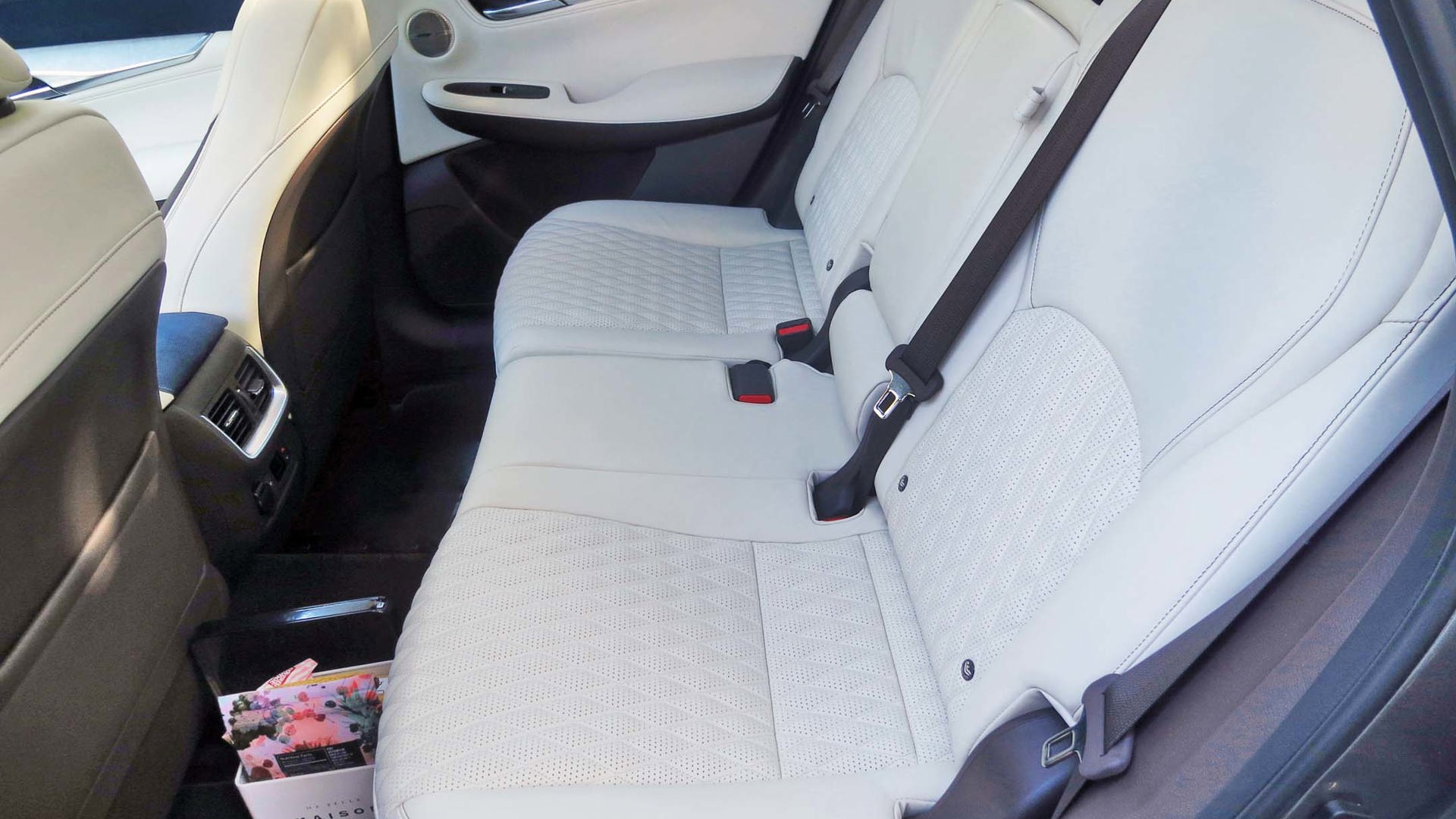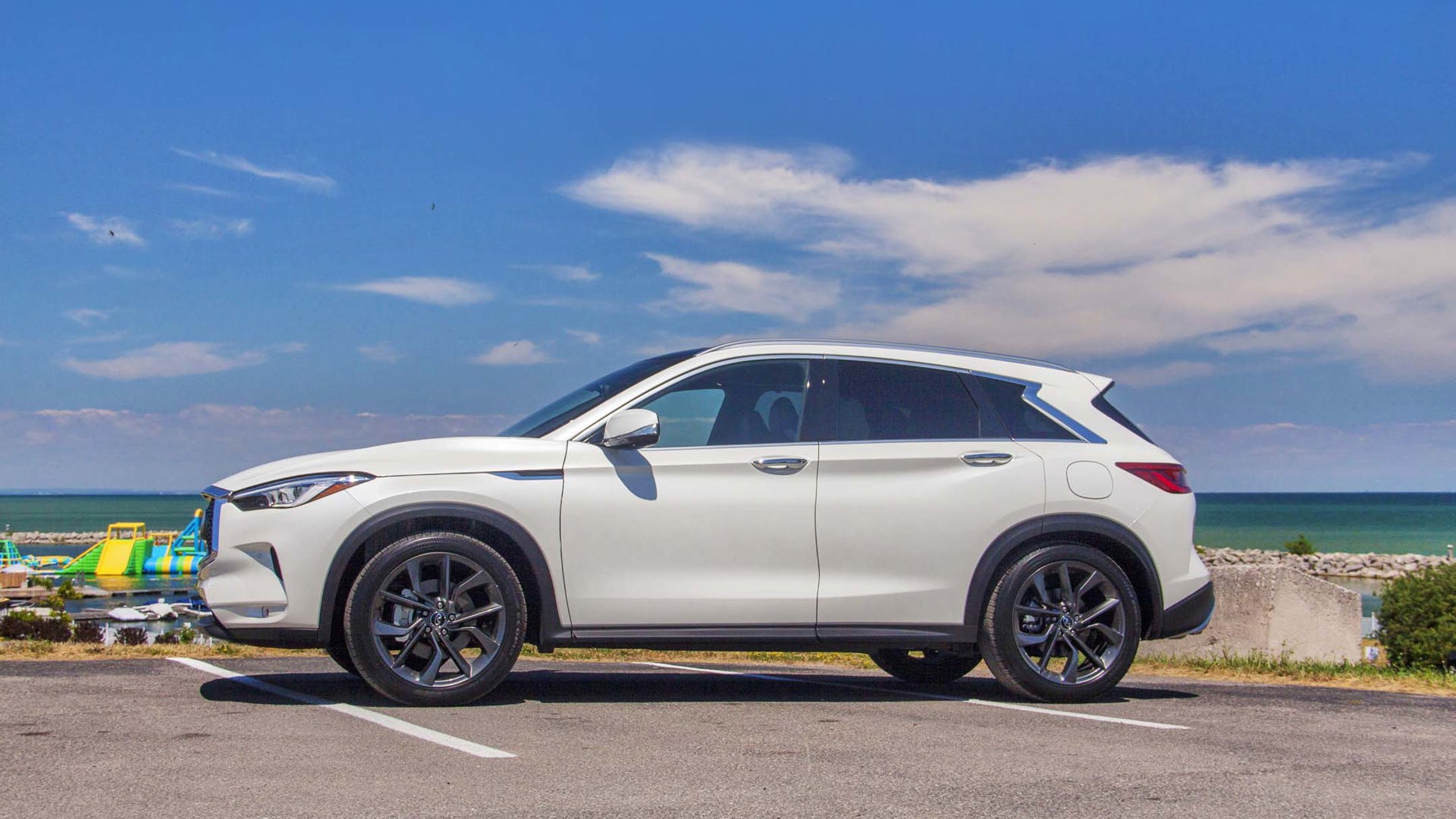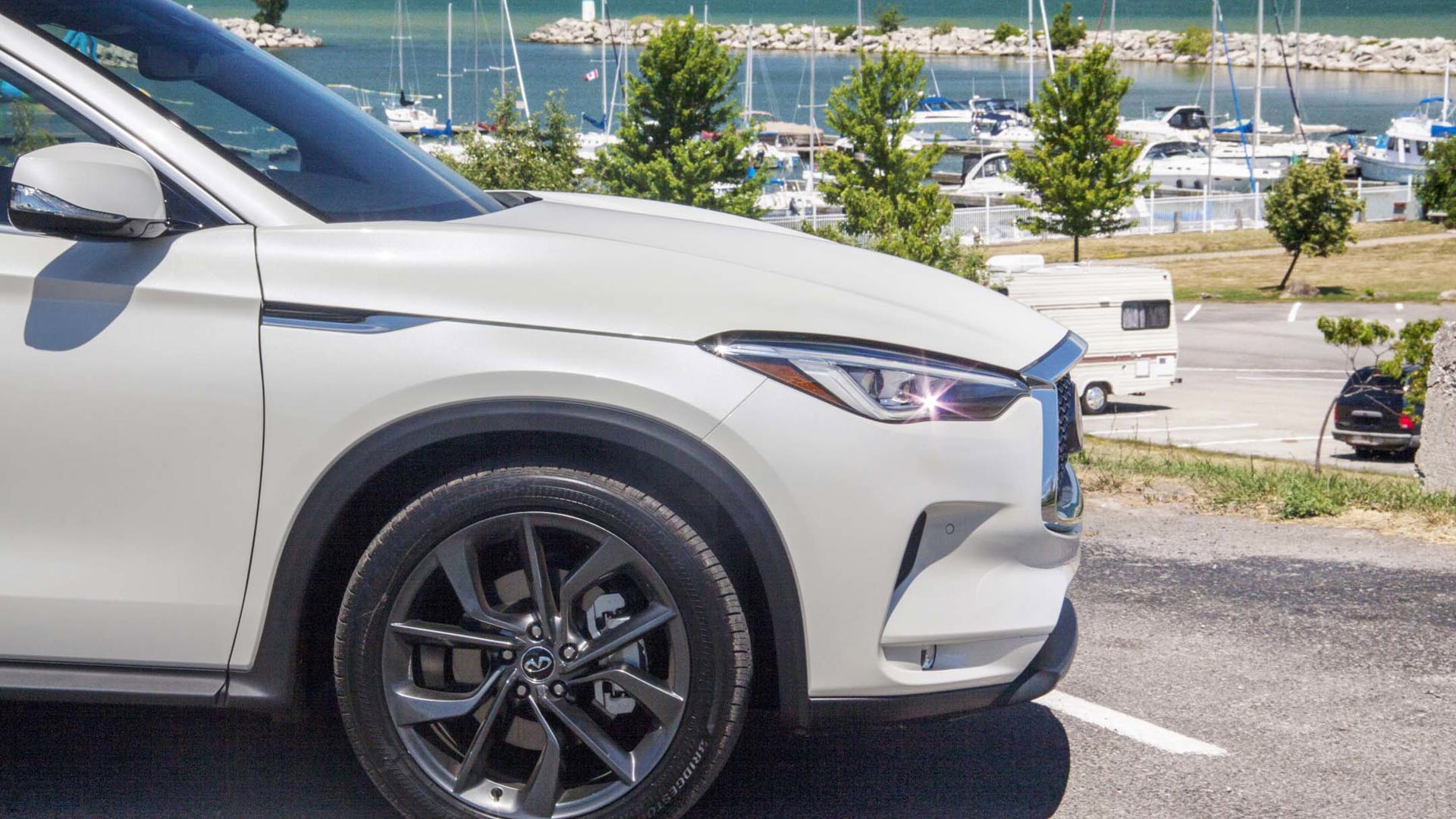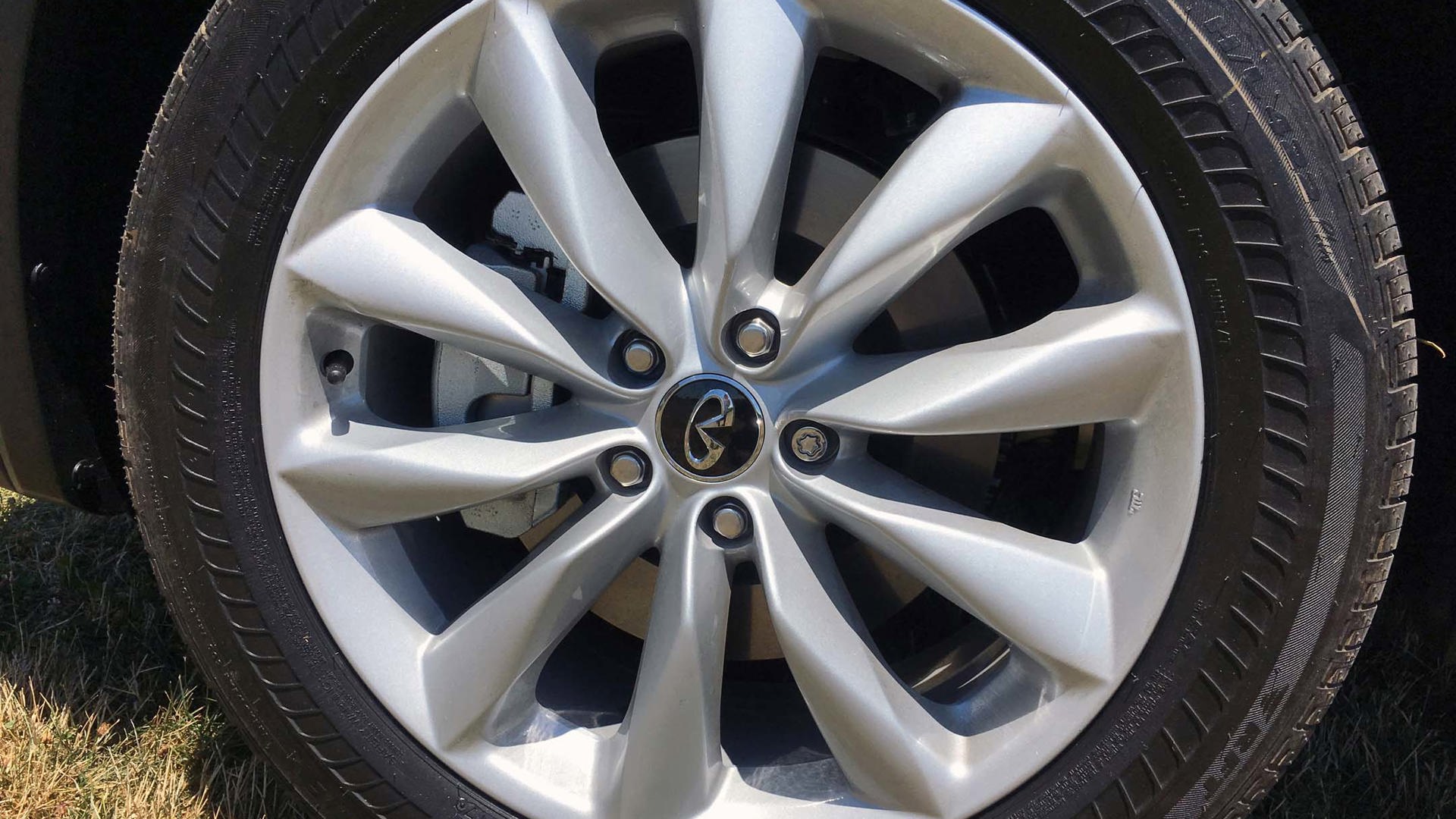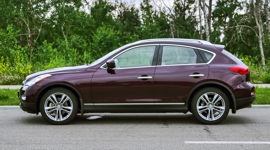NIAGARA, Ontario – The 2019 Infiniti QX50 is probably one of the most impressive makeover stories in recent memory. That’s a big statement when you consider the sheer volume of new crossovers flooding the market. Indeed, Infiniti claims it marks the most important vehicle launch in the history of their brand, with the expectation of it quickly becoming the most popular vehicle in their portfolio.
The most notable feature of the QX50 is Infiniti’s new Variable Compression Engine – a marvel of engineering that’s an industry first.
Taking note of what’s worked for the long-established leaders in the red-hot premium crossover segment, Infiniti swapped the QX50’s sporty, V6-powered, rear-wheel-drive layout for a more efficient front-drive – though Canadian models have standard AWD – turbocharged four-cylinder, and CVT transmission configuration. The nine-year-old vehicle returns not only with a prettier exterior and a first-rate cabin, but more importantly, it debuts the industry’s first variable-compression motor.
Sharp looks, award-winning interior
The first-gen QX50 was a rather nebulous jelly bean, soft and rounded with a wide generic face – albeit an absolute blast to drive. Sharp, handsome, the new design features a deep character line that runs around the entire vehicle, from the clamshell hood, through the LED taillights, and breaking up the expanse of side sheet metal. The signature C-pillar, peculiar-looking in some applications, is well-integrated into the overall design. Leaving no doubt about its identity, the crossover’s new “double-arched” grille bears an Infiniti badge the size of a dinner plate. Under the new skin is a high-tensile steel chassis, a rigid frame that increases torsional stiffness by 23 percent, yet weighs only 473 kg.
The cabin, winner of a “Ward’s Best Interiors” award, is very nicely wrought – an absolute necessity when competing against such premium brands as Mercedes-Benz, Audi, and BMW. The driver-centric cockpit features real wood trim that wraps around the dash and continues along the doors. The centre stack continues into a flowing centre console that neatly bisects the front cabin, and is finished in hand-stitched leather. Top-spec Sensory trim vehicles can be upgraded with an Autograph package that adds white premium-grade quilted leather with blue suede trim and piping.
The rather loftily named “NASA zero-gravity seats” reportedly reduce stress and pressure points for long-distance comfort. The second-row seats recline, and slide fore and aft. Trunk space, at 880 L one of the best in segment, increases to 1,048 L with the back row slid forward, and a maximum 1,822 L with it folded down. This is better than BMW X3’s 1,775 L, Audi Q5’s 1,710 L, or the Acura RDX’s 1,668 L.
Emphasis on comfortable, effortless driving
Our drive route from downtown Toronto placed us in the stop-and-go hell of morning rush hour – a perfect opportunity to test Pro Pilot Assist, Infiniti’s suite of driver assist technology that’s standard on the top trim levels. It’s a “hands-on” system that will operate fully on its own for about ten seconds before insisting that the driver take the wheel. Consisting of all the standard features typical of such safety assist systems, Pro Pilot is deployed by pushing a small blue button the steering wheel, which activates lane-keeping assist, adaptive cruise control with adjustable safe follow distance, forward collision warning, and emergency braking. We liked the unobtrusiveness of the system, which wasn’t as abrupt when increasing or decreasing speed as some systems.
Kudos to the sound-proofing engineers for the quiet comfort of the cabin, which benefits from extra insulation, acoustic glass, and some fancy new engine mounts which, like noise-cancelling software, apply an offset wave to cancel any occurring vibrations.
On the one hand, the two-tier information display lets you visit the home screen and other apps while still using the map navigation, but the nav screen itself is rather small. Strange too, is the absence of Apple CarPlay and Android Auto. But we liked the head-up display system, which was clearly visible even while wearing polarized glasses. The wide A-pillar and side mirror combination do present a bit of a visibility issue – a small window ahead, or even relocating the mirror to the door would probably help alleviate this.
A new “shift-by-wire” gear selector frees up a lot of space on the centre console, and uses the same simplified shifter as BMW, which does take a little getting used to. The QX50 is also the first Infiniti to feature drive by wire – which does away with any mechanical connection between you and the road, turning everything over to electronics and sensors. In my hands, the wheel felt light, disconnected, and overly boosted. Switching to Sport Mode (there are four: Standard, Eco, Sport, and Personal) added some heft to the steering, but it still lacked feedback.
Given its demographic, this is probably a plus, since it makes the QX50 extremely easy to wheel around parking lots and tight turns, but not as engaging to the enthusiast, who probably won’t be buying it anyway. That’s assuming the 59/41 front-to-rear weight ratio of the new vehicle hadn’t already removed it from their shopping list.
Variable Compression Engine an industry first
Of course, the most notable feature of the QX50 is Infiniti’s new Variable Compression Engine – a marvel of engineering that’s an industry first. The turbocharged four-cylinder is able to vary its compression rate between 8:1 and 14:1 depending on engine load – delivering peak horsepower and torque when needed – and operating with maximum efficiency when cruising or at idle.
How is this possible? Picking up a trapezoid of highly polished steel, I turned it over in my hands to study the intricate grooves milled into its surface. This is the multi-link mechanism, a vital component in the VC turbo’s ability to deliver the performance of a gasoline engine, with the torque and efficiency of a diesel. There’s one between each piston and the crank shaft, and depending on whether power or efficiency is required, its angle is adjusted by an actuator arm and electronic stimuli to adjust the height of piston travel.
A higher piston reduces the space between the piston head and cylinder, increasing compression ratio, while less piston travel produces a lower ratio. High compression equals better fuel economy, and when the VC engine is functioning at peak efficiency, the valve timing is adjusted to employ the Atkinson cycle.
The engine is able to switch seamlessly between these two extremes, with only the onboard information screen alerting you to its operation. It’s remarkably smooth, especially given the four-cylinder’s inherent tendency towards vibration. Most use a set of balancing shafts to combat this, which adds to complexity, and adds to parasitic power loss, but the Variable Compression Engine’s non-traditional crankshaft design doesn’t create the imbalance responsible for extra vibration. The engine also features an integrated exhaust manifold, reducing the distance that exhaust gases must travel to the turbo, and virtually eliminating turbo lag.
This marvellous little power plant is mated to a continuously variable transmission, not one of my favourite gearboxes by a long shot, but again, engineered to achieve maximum fuel efficiency. For the most part, it functions quietly and smoothly with none of the “rubber band” reluctance displayed by CVTs of old. Output is 268 horsepower at 5,600 rpm and a healthy 280 lb-ft of torque from 1,600 to 4,800 rpm. Hammer the throttle though, and you’re rewarded with the telltale “calfing heifer”, a sonorous moaning that’s an unfortunate departure from the previous model’s V6 snarl.
But the QX50’s stiff chassis makes it a very easy car to drive, threading in and out of Toronto traffic, and handling the curvy farmland roads of Niagara County without any pitch and roll. Overall, we achieved 8.7 L/100 km, mostly while driving in Sport Mode, compared to the official rating of 10.0 L city, 7.8 L highway, and 9.0 L combined – premium fuel only.
Pricing and Trims
There are five trim levels available, starting with the QX50 Luxe at $44,490.
Standard equipment includes LED headlights, paddle shifters, power lift gate, drive mode selector, heated front seats and wheel, remote start, engine block heater, wiper de-icer, pedestrian forward emergency braking, and predictive forward collision warning. All Canadian QX50s come with standard AWD.
Predicted to be the volume seller is the QX50 Essential ($48,990), which adds leather, navigations, parking sensors, moving object detection, tri-zone climate, rain-sensing wipers, power tilt and telescope, memory settings.
QX50 ProActive ($52,990) adds such safety technology as back-up collision intervention, distance-control assist, intelligent cruise control, rear cross-traffic alert, ProPilot Assist, steering assist, blind-spot intervention, lane-departure warning and prevention, head-up display, high-beam assist and Bose premium audio.
QX50 Sensory ($56,490) adds 20-inch wheels, premium leather, climate controlled seats, motion activated lift gate, adaptive front lighting, Ultrasuede headliner, maple wood trim, unique cube design headlights.
QX50 Autograph ($57,990) adds white premium quilted leather seating, blue Ultrasuede upper door and IP trim, blue piping.





